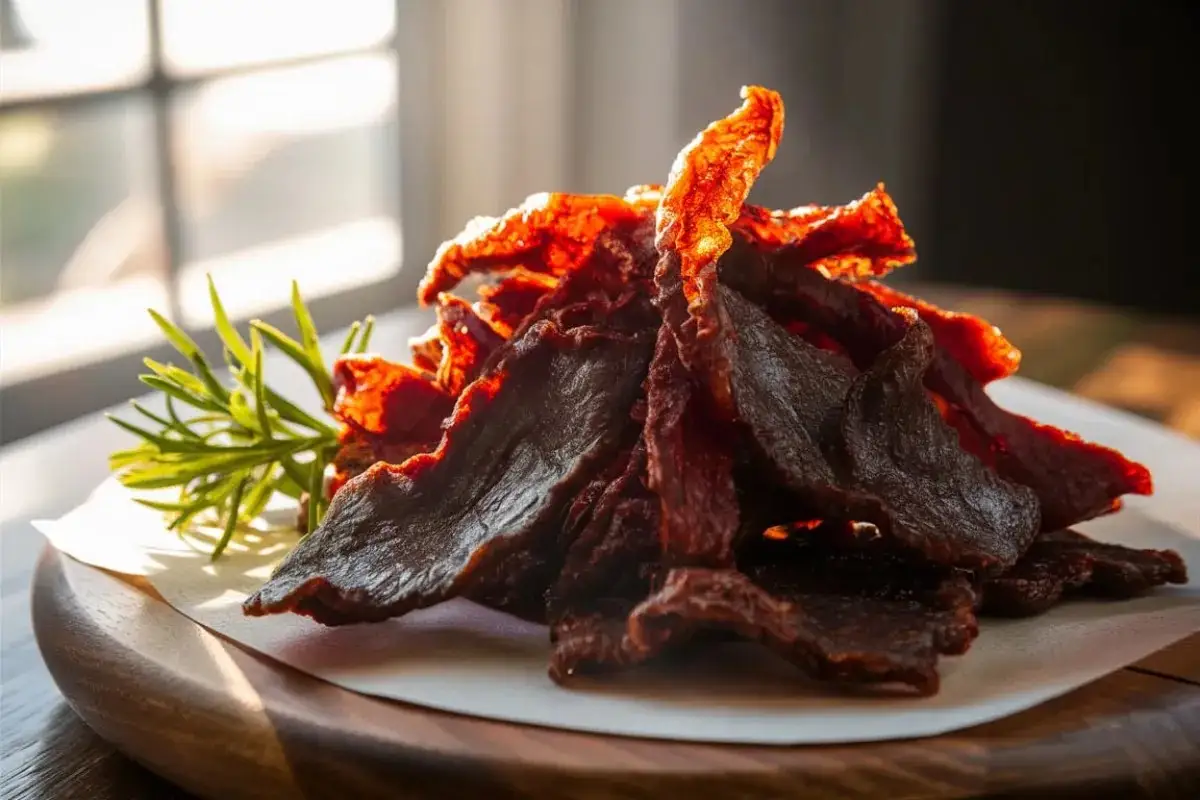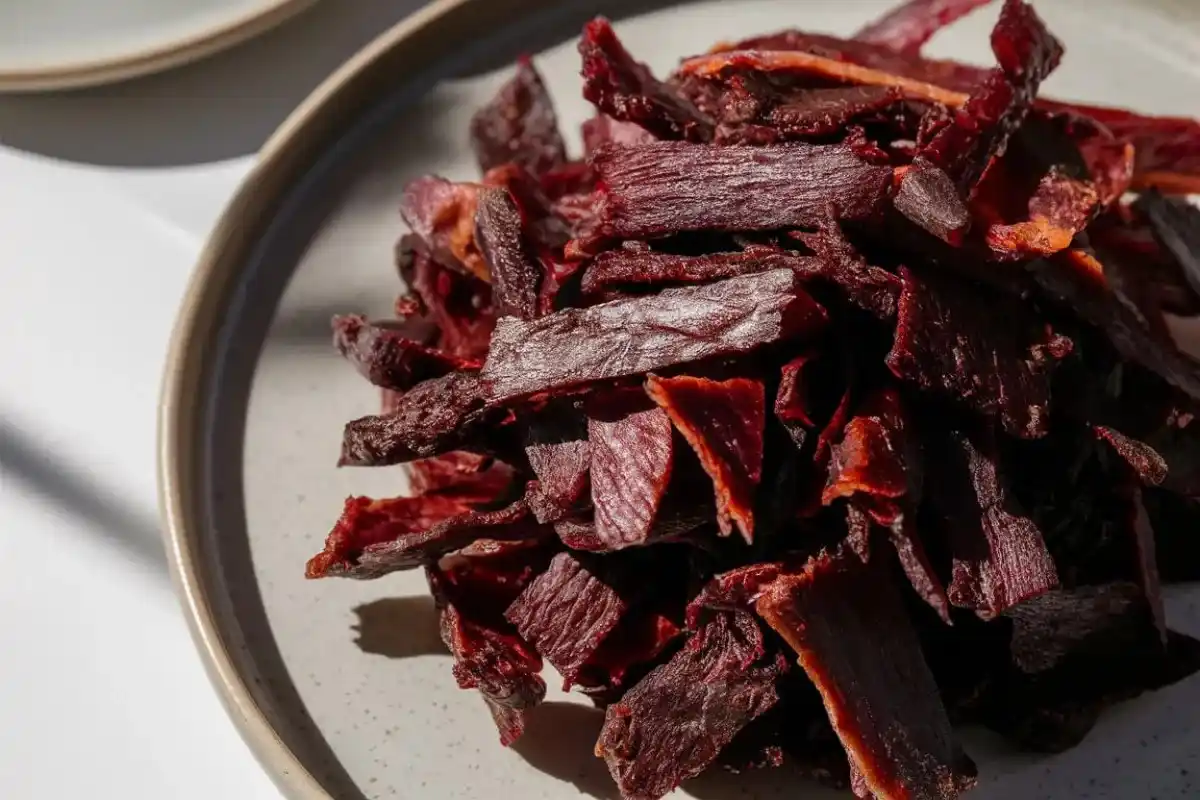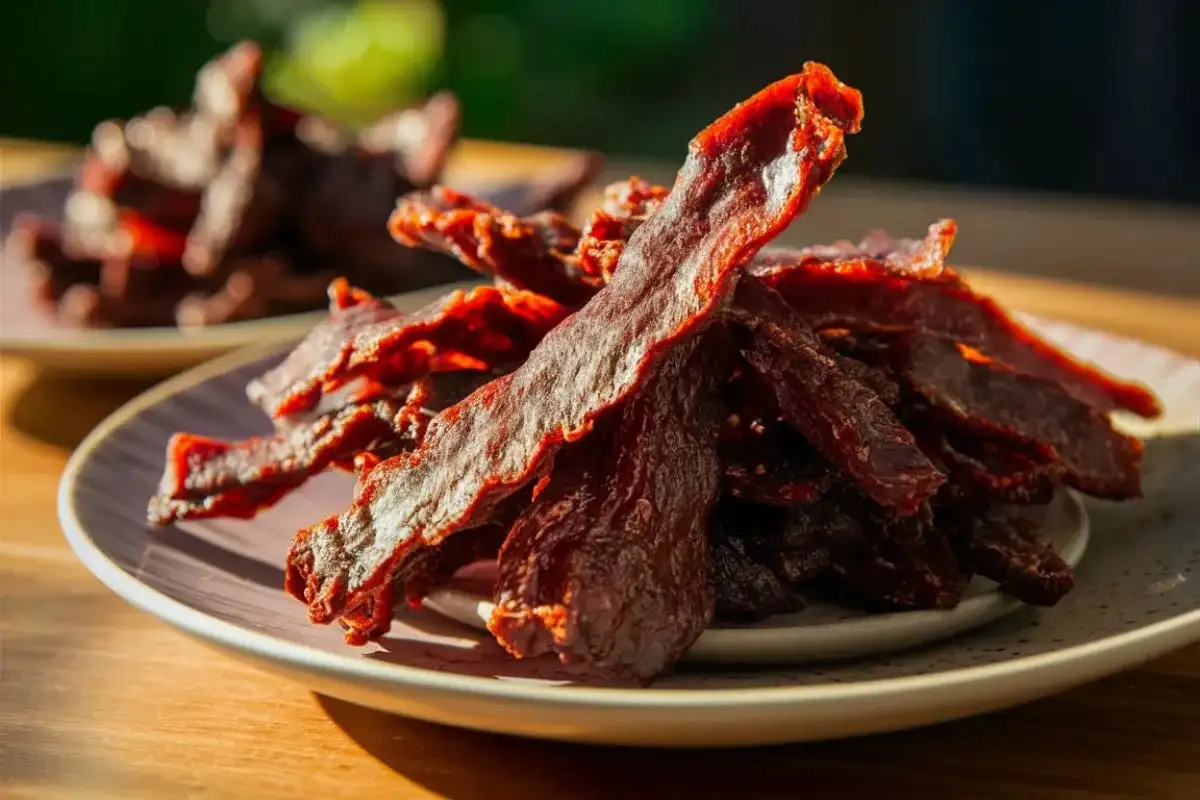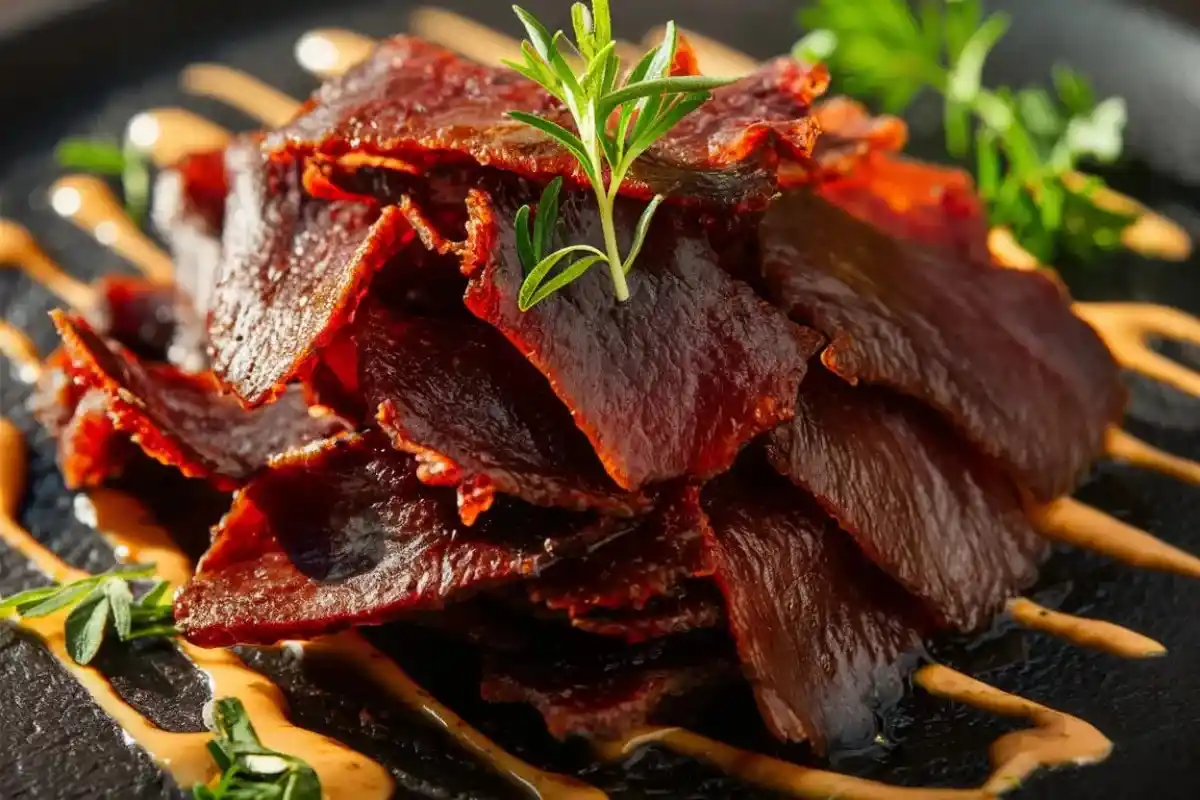Beef jerky is a highly popular snack, loved for its convenience, portability, and long shelf life. However, even though it is a preserved meat, beef jerky can still go bad under certain conditions. Knowing how to tell if beef jerky is bad is essential for anyone who enjoys this snack. This comprehensive guide covers how to tell if beef jerky is spoiled, why it spoils, how to store it properly, and tips for extending its shelf life. By understanding the signs of spoilage, you’ll be better equipped to determine if your beef jerky is still safe to eat
What is Beef Jerky?
How to tell if beef jerky is bad starts with understanding how it’s made. Beef jerky is made by curing strips of beef with salt, seasonings, and other preservatives before drying them to remove moisture. This process helps prevent bacterial growth and spoilage, making jerky an excellent option for long-term storage. However, the absence of moisture does not make it immune to spoilage, especially when exposed to air, moisture, or improper storage conditions. Knowing the signs of spoilage can help ensure you’re consuming safe and quality jerky.
Characteristics of Good Beef Jerky:
- Dry, Firm Texture: Properly made jerky is dry and firm but not overly brittle. It should have a slightly chewy texture that does not feel soft or mushy.
- Smoky, Savory Flavor: Depending on the recipe, jerky may have a smoky, spicy, salty, or slightly sweet taste that enhances the flavor of the meat.
- Long Shelf Life: Beef jerky can last for months when unopened and stored properly, making it a favorite snack for camping, road trips, and emergency food supplies.
Why Beef Jerky Can Spoil

How to tell if beef jerky is bad involves understanding that, even though beef jerky is dried to remove moisture, it is still susceptible to spoilage under certain conditions. Recognizing the factors that cause jerky to go bad can help you prevent these issues and keep your jerky fresh for as long as possible. Knowing what to look for will ensure you are always consuming safe and quality jerky.
Factors Leading to Spoilage:
- Moisture Exposure: Moisture is the biggest enemy of beef jerky. If jerky absorbs moisture from the air or through damaged packaging, it can lead to mold growth and spoilage.
- Air Exposure: Air contains oxygen, which can cause fats in the jerky to oxidize and turn rancid. Even a slight tear in the packaging can introduce air and shorten the jerky’s shelf life.
- Improper Storage Temperature: High temperatures can accelerate the degradation of jerky, leading to spoilage. Jerky stored in a warm or fluctuating environment is more prone to going bad.
- Poor Sealing: If the packaging is not airtight, jerky is more likely to spoil quickly. Proper sealing prevents air and moisture from entering the package.
For more tips on storing jerky effectively, you can learn about how to store beef jerky long term to keep it fresh.
Signs of Spoiled Beef Jerky
Recognizing the signs of spoiled jerky is crucial to avoid eating bad meat. Here are detailed ways to determine whether your beef jerky has gone bad.
1. Changes in Color
- What to Look For: Fresh beef jerky has a consistent dark brown or reddish color, depending on the seasoning. Spoiled jerky may look dull, gray, or have unusual spots or discoloration.
- Why It Matters: Color changes can indicate oxidation or mold growth, both of which are signs that the jerky is no longer good.
2. Texture Alterations
- What to Look For: Fresh jerky is firm yet pliable. Spoiled jerky may feel overly hard, crumbly, mushy, or sticky.
- Why It Matters: Changes in texture often indicate that the jerky has absorbed moisture or has started to degrade, making it unsafe to eat.
3. Visible Mold
- What to Look For: Mold may appear as fuzzy white, green, or black spots on the jerky surface.
- Why It Matters: Mold is a clear indication of spoilage. Even small patches of mold mean that the entire piece of jerky is compromised and should not be eaten.
4. Unpleasant Odors
- What to Look For: Fresh jerky should have a rich, smoky, and slightly salty aroma. Spoiled jerky emits a sour, musty, or rancid smell that is immediately noticeable.
- Why It Matters: A foul odor is one of the most reliable indicators that jerky has gone bad. Trust your nose if it smells off, it likely is.
5. Changes in Taste
- What to Look For: While it’s not advisable to taste jerky you suspect is spoiled, jerky that tastes stale, sour, or has an off flavor is a sign it has degraded.
- Why It Matters: Unpleasant taste changes indicate the jerky is no longer safe to consume. Always rely on other signs before tasting suspected spoiled jerky.
6. Moisture Inside the Packaging
- What to Look For: Condensation or visible moisture droplets inside the packaging.
- Why It Matters: Moisture inside the packaging can lead to mold growth and spoilage. Jerky should be completely dry, and any signs of moisture indicate it is no longer safe.
How Long Does Beef Jerky Last?

Beef jerky’s shelf life varies based on the type of jerky, its preparation, and how it is stored. Knowing the general guidelines for jerky longevity can help you consume it while it’s still fresh.
Shelf Life by Type:
- Commercial Beef Jerky: Thanks to preservatives and vacuum sealing, store-bought jerky can last 1-2 years when unopened. Always check the expiration date, but jerky stored properly can often be good beyond this timeframe if there are no signs of spoilage.
- Homemade Beef Jerky: Without the benefit of commercial preservatives, homemade jerky usually lasts 1-2 months if stored in an airtight container in a cool, dry place.
- Opened Jerky: Once opened, jerky’s shelf life diminishes rapidly. Consume opened jerky within a week or store it in the refrigerator to extend its freshness.
For more specific guidelines, you can explore how long different types of jerky last.
The Role of Storage in Jerky Shelf Life
Proper storage is critical for maintaining the quality and longevity of beef jerky. Here are essential tips to keep your jerky fresh:
- Store in a Cool, Dry Place: Heat and humidity are enemies of jerky. Always store your jerky in a pantry or cupboard away from direct sunlight and fluctuating temperatures.
- Use Airtight Containers: If you remove jerky from its original packaging, transfer it to an airtight container or resealable plastic bag to protect it from air and moisture.
- Refrigerate After Opening: Storing opened jerky in the refrigerator can extend its shelf life by slowing the oxidation process and keeping moisture at bay.
Signs of Spoilage After Opening
Once you open a package of jerky, it becomes more susceptible to environmental factors. Here’s how to check your jerky for spoilage after opening:
- Inspect Regularly: Look for any changes in appearance, texture, or smell each time you consume the jerky.
- Smell Test: Always sniff the jerky before eating. Any off or sour smell is a sign it should be discarded.
- Feel the Texture: Check that the jerky is still dry and firm. Any signs of stickiness, excessive softness, or moisture suggest spoilage.
Tips to Extend the Shelf Life of Beef Jerky
To maximize the shelf life of your beef jerky, follow these storage and handling tips:
- Seal Packaging Tightly: Keep the packaging tightly sealed to prevent exposure to air. Use clips or resealable bags if the original packaging cannot be resealed.
- Use Silica Gel Packs: Including silica gel packs in your storage container can help absorb any residual moisture and prevent spoilage.
- Avoid Frequent Temperature Changes: Store jerky in a stable environment away from heat sources such as stoves, heaters, or windows.
- Portion Control: If you open a large package, consider dividing it into smaller portions to minimize air exposure each time you access the jerky.
Common Mistakes in Storing Beef Jerky

How to tell if beef jerky is bad often starts with proper storage practices, as this is key to maintaining the quality of beef jerky. However, there are common mistakes people make that can lead to premature spoilage, making it crucial to recognize these errors and store your jerky correctly to ensure it remains fresh and safe to eat
Leaving Jerky Exposed to Air
- Issue: Air exposure can lead to oxidation and moisture absorption.
- Solution: Always seal jerky tightly after opening. Use airtight bags or containers to keep out air.
Storing Jerky in Warm Places
- Issue: High temperatures accelerate spoilage by promoting fat oxidation and bacterial growth.
- Solution: Store jerky in a cool, stable environment away from heat sources.
Not Inspecting Jerky Regularly
- Issue: Over time, jerky can spoil even when stored properly, especially after opening.
- Solution: Regularly check your jerky for signs of spoilage. Smell, texture, and appearance are key indicators.
Best Practices for Storing Different Types of Jerky
Different types of jerky, such as beef, turkey, or venison, may have slightly varying storage needs based on fat content and preparation methods. Here are some tailored tips for storing various types of jerky:
- Beef Jerky: Store in cool, dry places. If it’s a high-fat jerky, refrigerate after opening to prevent rancidity.
- Turkey Jerky: Generally lower in fat, turkey jerky can still absorb moisture easily. Keep it sealed tightly and refrigerate after opening for optimal freshness.
- Venison Jerky: Venison jerky, often leaner, should be stored in airtight containers and consumed relatively quickly after opening to maintain texture.
Frequently Asked Questions
Q1: Can beef jerky go moldy?
Yes, beef jerky can develop mold if it absorbs moisture or is stored improperly. Mold appears as fuzzy patches and can range in color from white to green or black. Always discard moldy jerky, as it is no longer safe to eat.
Q2: What should I do if my jerky smells bad?
If your jerky has an unusual or off smell, it’s best to err on the side of caution and discard it. A bad smell is one of the most telling signs that the jerky is spoiled.
Q3: Is it safe to eat jerky past the expiration date?
Jerky past its expiration date can still be safe if it shows no signs of spoilage, such as mold, off odors, or texture changes. However, consuming expired jerky always carries some risk, so inspect it carefully.
Q4: Can beef jerky be stored in the freezer?
Yes, freezing beef jerky can extend its shelf life even further. Freezing stops the oxidation process and keeps the jerky safe from moisture and air. Thaw frozen jerky slowly to maintain its texture and flavor.
Q5: How can I make my jerky last longer?
To extend the shelf life of your jerky, keep it in an airtight container, store it in a cool, dark place, and consider refrigerating or freezing it after opening. Silica gel packs can also help absorb any residual moisture.
Conclusion
How to tell if beef jerky is bad is essential for ensuring that you are consuming a quality product. Identifying spoiled beef jerky involves looking for telltale signs such as changes in color, texture, smell, and the presence of mold. Proper storage techniques, such as using airtight containers, refrigerating after opening, and keeping jerky away from heat and moisture, can significantly extend its shelf life and help you avoid eating jerky that has gone bad.
By taking care of your jerky and inspecting it regularly, you can enjoy this tasty snack safely and for longer periods. Always remember that when in doubt, it’s better to discard questionable jerky than risk consuming a product that has spoiled. For more insights into keeping your jerky fresh, explore further on why beef jerky might go bad and how to store it effectively.
With these tips and knowledge, you can confidently enjoy beef jerky at its best, knowing how to keep it fresh and safe for consumption.

